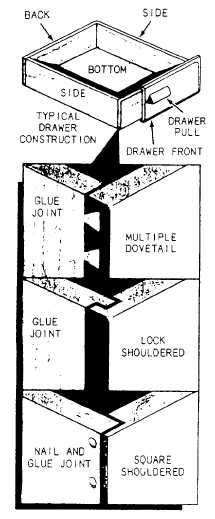plumb end stile first, and then attach rails to determine the position of the next stile.
Use finishing nails and glue to install facing, When nailing hardwoods, drill nail holes where you think splitting might occur.
Drawers
Seabees use many methods of building drawers. The three most common are the multiple dovetail, lock-shouldered, and square-shouldered methods (figure 3-73).
There are several types of drawer guides available. The three most commonly used are the side guide, the corner guide, and the center guide (shown in figure 3-74, view A).
The two general types of drawer faces are the lip and flush faces (shown in figure 3-74, view B), A flush drawer must be carefully fitted. A lip drawer must have a rabbet along the top and sides of the front. The lip style overlaps the opening and is much easier to construct.
Cabinet Doors
The four types of doors commonly used on cabinets are the flush, lipped, overlay, and sliding doors. A flush door, like the flush drawer, is the most difficult to construct. For a finished look, each type of door must be fitted in the cabinet opening within 1/16-inch clearance around all four edges. A lipped door is simpler to install than a flush door since the lip, or overlap, feature allows you a certain amount of adjustment and greater tolerances. The lip is formed by cutting a rabbet along the edge.
Overlay doors are designed to cover the edges of the face frame. There are several types of sliding doors used on cabinets. One type of sliding door is rabbeted to fit into grooves at the top and bottom of the cabinet. The top groove is always made to allow the door to be removed by lifting it up and pulling the bottom out.

Figure 3-73.-Three common types of joints used in drawer construction.
INSTALLING PREMADE CABINETS
To install premade cabinets, you can begin with either the wall or base cabinets. The general procedures for each are similar.
Installing the Wall Cabinets First
When layouts are made and wall studs located, the wall units are lifted into position. They are held with a padded T-brace that allows the worker to stand close to the wall while making the installation. After the wall cabinets are securely attached and checked, the base cabinets are moved into place, leveled, and secured.
Installing the Base Cabinets First
When base cabinets are installed first, the tops of the base cabinets can be used to support braces that hold the wall units in place while they are fastened to the wall.
Continue Reading